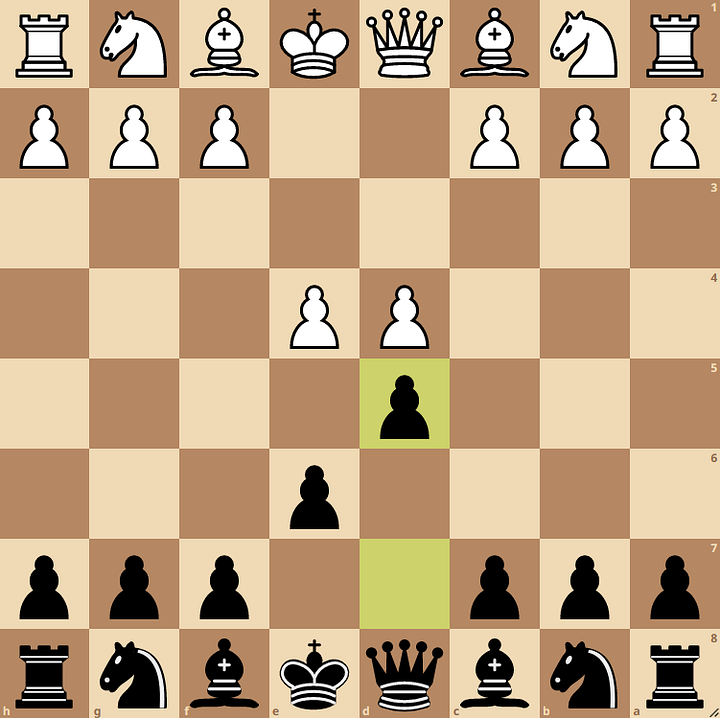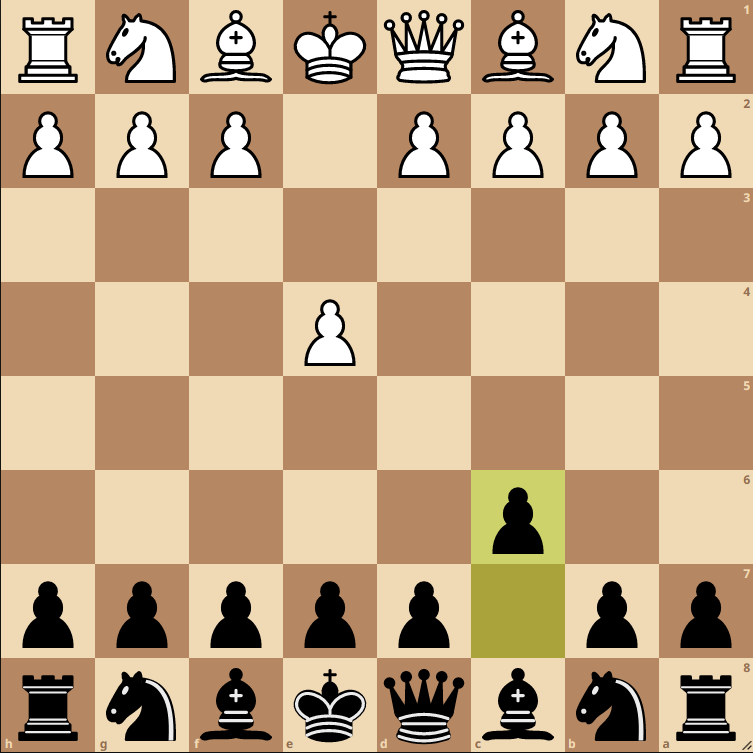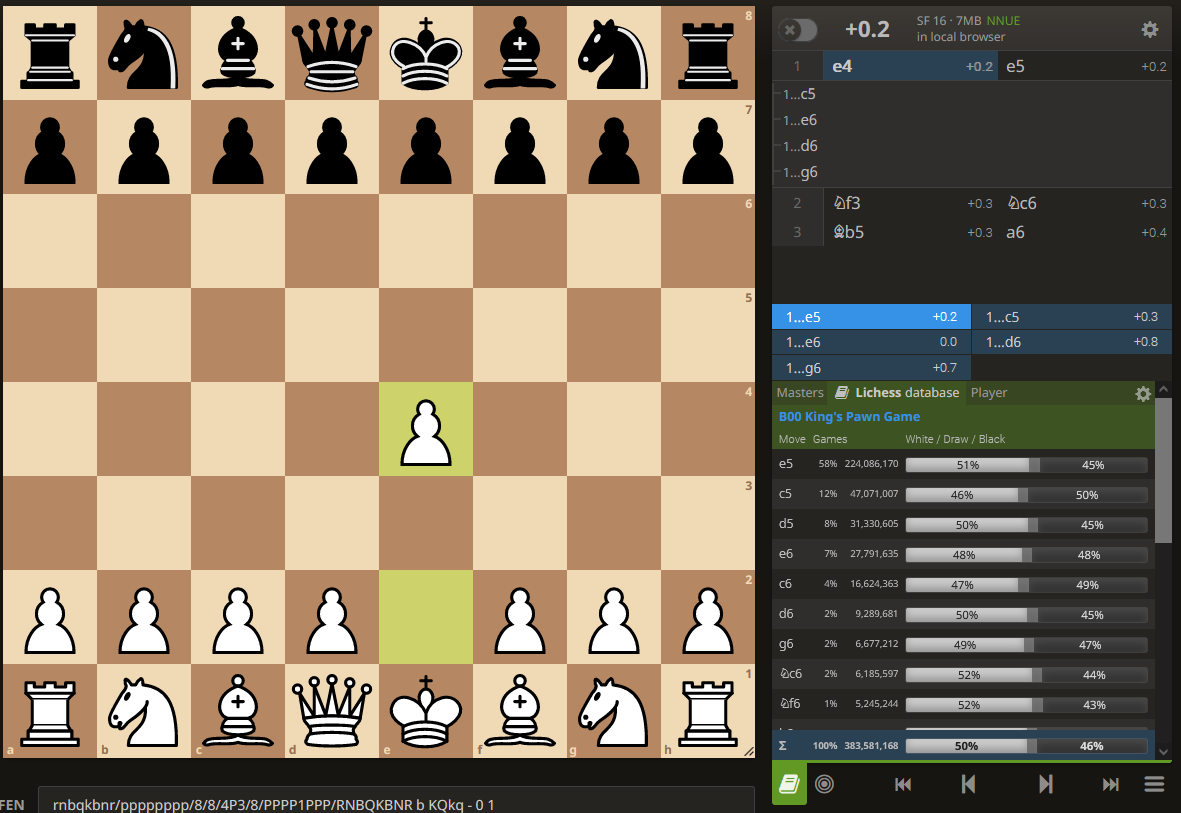The Caro-Kann is the first chess opening I’ve gone into detail trying to understand. And I’m not gonna lie… It feels quite daunting!
Like most openings, the Caro-Kann has multiple variations to worry about. Luckily the ideas that black puts in place largely remain the same for each. For that reason, I’ll be following the 80/20 principle for learning this opening.
How will this play out?
I’ll focus on the variations/lines that make up roughly 80% of all rapid chess games at the sub-1600 rating level. After all, why learn what the GMs play when I wont be playing any GMs?
So… Here we have the first part of what will be at least a 4 part series (possibly more) of the most common Caro-Kann variations played under 1600 rating.
Table of Contents
What is the Caro-Kann Defense?
This is it. When white plays e4 and black plays c6, the Caro-Kann is on.
But wait, you might be saying. doesn’t white play d4 and black play d5? That is sort-of correct, but some variations need to be mentioned. (Which we’ll get to below.)
But in every variation we’ll be talking about, black always responds with d5 as the second move. So no matter what, for black, the Caro-Kann is about setting up the move d5 in order to give black an advantage on pawn structure.
The trade-off is that white gets an advantage on space and development.
Why Play the Caro-Kann?
“I think it’s just one of the best openings you can play as a beginner. I can’t think of a better opening for a beginner. Because it’s just straight forward.”
-GM Hikaru Nakamura
I can’t think of a better endorsement than that!
This quote is taken from a beginner chess opening tier list video done with GM Nakamura and IM Levy Rozman. Simply put, the Caro-Kann is widely considered one of the most solid openings for black against e4.
But is it really the best opening for black? Let’s take a look at the numbers, according to the Lichess database…
What do these two images tell us about the Caro-Kann?
For the Masters Database, c6 is one of the best at limiting white’s upside. e5 limits white’s win potential the most, but the trade-off is more ties. (30% win rate for white, 21% win rate for black.) c6, on the other hand, tilts the game toward more decisions with each side gaining 3% chance to win.
Only one opening gives masters a better win rate differential, c5 - the Sicilian Defense.
For the under 1600 database, c6 jumps ahead of e5 in providing black chances for the win. Just like the Masters Database, the Caro-Kann is second only to c5 (the Sicilian Defense) for win rate differential.
Caro-Kann vs Sicilian
If the Sicilian defense provides better outcomes for black, why play the Caro-Kann at all? The answer is simple: preference.
The super simple explanation is that the Sicilian tends to be riskier whereas the Caro-Kann is more solid. The Sicilian provides black with more opportunities, but there are also a TON of variations to worry about, which means a TON of theory.
The Caro-Kann, on the other hand, has very similar themes throughout all the variations. There may be slightly less opportunity for black, but there is also a lot less to worry about from a theory perspective. As IM Levy Rozman (GothamChess) says in the video above, the basics can be learned in about 10-minutes.
But that doesn’t mean you can’t start with the Sicilian. Check out some videos and if the style seems to suit you better, feel free to jump into that one.
Caro-Kann Lines based on the 80/20 Principle



Making up exactly 80% of rapid games played in the sub-1600 range, we have the three variations that will make up this Caro-Kann guide. In order from left to right the exact probability of reaching each position (after playing c6, of course) is 38%, 30%, and 12%.
The first two don’t have a specific variation name. Both are simply called “Caro-Kann Defense” in the Lichess database. However, the third one has my favorite name I’ve come across so far — Caro-Kann Defense: Hillbilly Attack.
As you can see, black responds with d5 in each variation, challenging white’s center immediately.
We’ll go into each of these lines in detail as the series continues. For now, let’s look at the basic theory for black when playing the Caro-Kann.
Basic Theory for Black
Caro-Kann is often compared with the French Defense due to a very similar pawn structure.


The French Defense, while solid, has a major draw back for black — the light square bishop. As you can see, the French Defense leaves the bishop stuck in the pawn chain.
The Caro-Kann avoids this by using c6 as support for d5, rather than e6. The main idea in each of these variations is to free the light square bishop early, and secure the pawn structure.
Check the examples below…



These are some common lines based on the 3 variations shown above. In each black has brought the bishop out and further supported the center with e6 AFTER the bishop is free.
The game doesn’t always go so smoothly. Often black develops a knight (or both) before the bishop. But the goal is for a setup like the ones you see above — light square bishop development + solid pawn structure.
What is so special about this setup?
You may correctly notice that black has given white quite a bit of space to work with. Development, in general, will be easier for white. However, black gains an extremely solid pawn structure in the middle of the board.
In each variation above, white is going to have to find a way to break down black’s structure. Not such an easy task! Especially at the sub-1600 level.
In pt 2 we will go in depth with the Advanced Variation, as well as a look at the Exchange Variation.
Until then! ✌🏻






